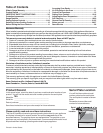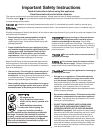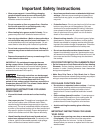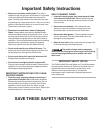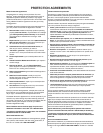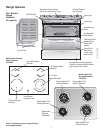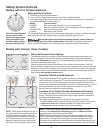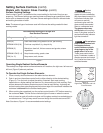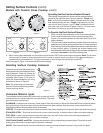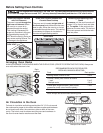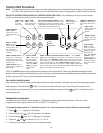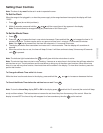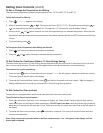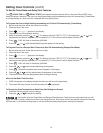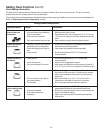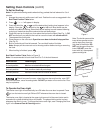
10
Figure 1
Figure 2
Figure 3
Figure 4
Selecting Surface Cooking Cookware
Setting Surface Controls (cont’d)
Models with Ceramic Glass Cooktop (cont’d)
To Operate the Dual Surface Element:
1. Place correctly sized cookware on the dual surface element.
2. Push in and turn the control knob counterclockwise (See
Figure 1) for smaller cookware or clockwise (See Figure 3) for
larger cookware.
3. Turn the knob to adjust the setting if needed. Start most cooking
operations on a higher setting and then turn to a lower setting to
finish cooking. Each surface element provides a constant amount
of heat at each setting. A glowing red surface heating area
extending beyond the bottom edge of the cookware indicates the
cookware is too small for the surface heating area.
Operating the Dual Surface Radiant Element
The cooktop is equipped with a dual radiant surface element
located at the right front (See Figure 4) position. “Single and
Dual” on the control knob are used to indicate which coil of the
dual radiant element will heat. “Single” indicates that only the
inner coil will heat (Figures 1 and 2). “Dual” indicates that both
inner and outer coils will heat (Figures 3 and 4). You may switch
from either coil setting at any time during cooking.
Figure 6
Figure 5
Cookware should have flat bottoms that
make good contact with the entire surface
heating element. Check for flatness by
rotating a ruler across the bottom of the
cookware (See Figure 5). Be sure to
follow the recommendations for using
cookware as shown in Figure 6.
Note: The size and type of cookware
used will influence the setting needed
for best cooking results.
4. When cooking has completed, turn the surface control knob to OFF before removing the cookware. Note: The Surface
Indicator light will come on when the control knob is turned on and will continue to glow until the glass cooktop has
cooled down to a moderate level. The light may remain on even though the controls are turned OFF.
Note: See page 9, Figure 1 for recommended control settings.
Cookware Material types
The cookware material determines how evenly and quickly heat is
transferred from the surface element to the pan bottom. The most
popular materials available are:
ALUMINUM - Excellent heat conductor. Some types of food will cause it to darken (Anodized aluminum cookware resists
staining & pitting). If aluminum pans slide across the ceramic glass cooktop, they may leave metal marks which will
resemble scratches. Remove these marks immediately.
COPPER - Excellent heat conductor but discolors easily. May leave metal marks on ceramic glass (see Aluminum above).
STAINLESS STEEL - Slow heat conductor with uneven cooking results. Is durable, easy to clean and resists staining.
CAST IRON - A poor heat conductor however will retain heat very well. Cooks evenly once cooking temperature is
reached. Not recommended for use on ceramic cooktops.
PORCELAIN-ENAMEL on METAL - Heating characteristics will vary depending on base material. Porcelain-enamel
coating must be smooth to avoid scratching ceramic cooktops.
GLASS - Slow heat conductor. Not recommended for ceramic cooktop surfaces because it may scratch the glass.
Correct Incorrect



